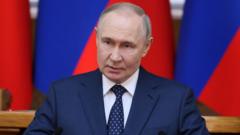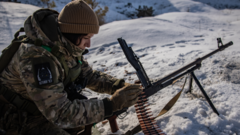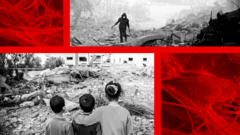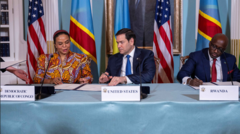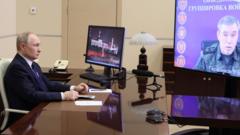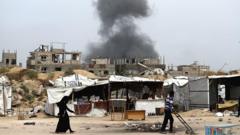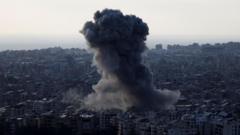Recent live footage of released Israeli hostages has provoked a mix of horror and anger among the public, complicating ceasefire continuity with Hamas. As concerns grow over the treatment of both Israeli hostages and Palestinian prisoners, the dynamics of ongoing negotiations become increasingly precarious.
Anguish Over Hostage Releases Poses Challenges to Ongoing Ceasefire
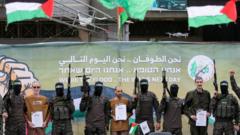
Anguish Over Hostage Releases Poses Challenges to Ongoing Ceasefire
The visible deterioration of freed hostages sparks increased frustration in Israel, raising concerns about the future of fragile ceasefire negotiations with Hamas.
In a striking moment broadcast globally, Eli Sharabi, one of the recently freed hostages, appeared gaunt and distressed alongside masked Hamas fighters, prompting mixed emotions among Israelis. When asked how he felt, he responded joyfully about reuniting with his family, unaware of the tragedy that had befallen them during Hamas’s attack on October 7, 2023. This staged handover was evident in its production quality, contrasting with the frail appearances of the returned individuals.
As images of the overwhelmed hostages flooded Tel Aviv's Hostages Square, the atmosphere shifted from one of relief to deep sorrow. Ruth Senderovich, a spectator, articulated the conflict of emotions—joy intertwined with heartbreak—echoing wider sentiments as the public grappled with the visual and emotional toll of the hostages’ trauma.
Prime Minister Benjamin Netanyahu’s reaction was one of a solemn commitment to address the distressing imagery, asserting that Israel would take action, though specifics were lacking. Meanwhile, the International Committee of the Red Cross expressed concern over the conditions surrounding the releases, emphasizing the need for dignity and privacy in such operations.
Criticism was also leveled at Hamas for the perceived interaction with their hostages. Following the exchange, 183 Palestinian detainees were released from Israeli prisons, raising questions about their treatment. Reports emerged that some of these individuals had been subjected to maltreatment during their incarceration, echoing claims of abuse leveled at Israeli authorities.
Negotiations surrounding the ceasefire are now fraught with uncertainty. Israel's government is engaging with negotiators in Qatar, creating space for technical discussions before addressing the next phase. Concurrently, Hamas conveyed frustration over Israel's commitment to the ceasefire while indicating willingness to participate in discussions.
A produced video of the three hostages’ release, showing their gratitude and transformation as they donned uniforms decorated with their own images, was released by Hamas, and subsequently met with a plea from families to halt its broadcast. Many observers contend that the deteriorated conditions of hostages underscore the urgent need for a comprehensive resolution to meet the humanitarian costs that have steeply escalated on both sides.
As images of the overwhelmed hostages flooded Tel Aviv's Hostages Square, the atmosphere shifted from one of relief to deep sorrow. Ruth Senderovich, a spectator, articulated the conflict of emotions—joy intertwined with heartbreak—echoing wider sentiments as the public grappled with the visual and emotional toll of the hostages’ trauma.
Prime Minister Benjamin Netanyahu’s reaction was one of a solemn commitment to address the distressing imagery, asserting that Israel would take action, though specifics were lacking. Meanwhile, the International Committee of the Red Cross expressed concern over the conditions surrounding the releases, emphasizing the need for dignity and privacy in such operations.
Criticism was also leveled at Hamas for the perceived interaction with their hostages. Following the exchange, 183 Palestinian detainees were released from Israeli prisons, raising questions about their treatment. Reports emerged that some of these individuals had been subjected to maltreatment during their incarceration, echoing claims of abuse leveled at Israeli authorities.
Negotiations surrounding the ceasefire are now fraught with uncertainty. Israel's government is engaging with negotiators in Qatar, creating space for technical discussions before addressing the next phase. Concurrently, Hamas conveyed frustration over Israel's commitment to the ceasefire while indicating willingness to participate in discussions.
A produced video of the three hostages’ release, showing their gratitude and transformation as they donned uniforms decorated with their own images, was released by Hamas, and subsequently met with a plea from families to halt its broadcast. Many observers contend that the deteriorated conditions of hostages underscore the urgent need for a comprehensive resolution to meet the humanitarian costs that have steeply escalated on both sides.


